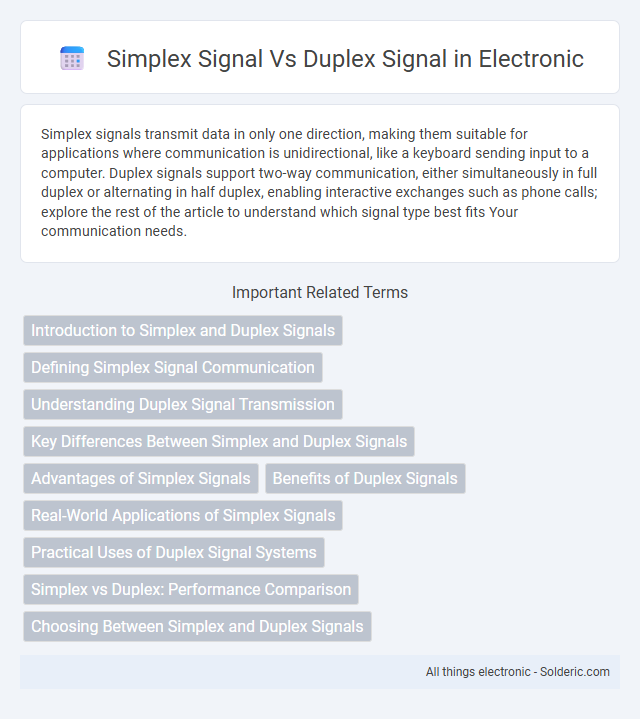Simplex signals transmit data in only one direction, making them suitable for applications where communication is unidirectional, like a keyboard sending input to a computer. Duplex signals support two-way communication, either simultaneously in full duplex or alternating in half duplex, enabling interactive exchanges such as phone calls; explore the rest of the article to understand which signal type best fits Your communication needs.
Comparison Table
| Feature | Simplex Signal | Duplex Signal |
|---|---|---|
| Definition | One-way communication signal | Two-way communication signal |
| Direction | Unidirectional | Bidirectional |
| Example | TV broadcast | Telephone call |
| Channel Usage | Single channel, one direction | Single or dual channel, both directions |
| Communication Type | Simplex signal transmission | Half-duplex or full-duplex signal transmission |
| Latency | Lower latency due to one-way flow | Variable latency depending on switching or simultaneous transmission |
| Use Cases | Radio, keyboard input | Internet, telephone, two-way radios |
Introduction to Simplex and Duplex Signals
Simplex signal transmission allows data to flow in only one direction, making it suitable for devices like keyboards or microphones where communication is unidirectional. Duplex signals enable data to travel in both directions; half-duplex supports bidirectional communication but not simultaneously, common in walkie-talkies, while full-duplex allows simultaneous two-way data transfer, as seen in telephone networks. Understanding the differences between simplex and duplex signals is essential for designing efficient communication systems tailored to specific application requirements.
Defining Simplex Signal Communication
Simplex signal communication allows data to flow in only one direction, meaning the transmitter sends information while the receiver solely listens without sending feedback. This unidirectional transmission is typical in devices like keyboards or traditional television broadcasts where Your interaction is not required for data flow. While simpler and more cost-effective, simplex systems lack two-way communication capabilities found in duplex signaling.
Understanding Duplex Signal Transmission
Duplex signal transmission enables two-way communication by allowing signals to be sent and received simultaneously, unlike simplex transmission which only supports one-way signal flow. Full duplex systems use separate channels or frequency bands to facilitate concurrent sending and receiving of data, significantly improving communication efficiency in networks such as telephony and internet connections. Understanding duplex transmission is essential for optimizing data throughput and reducing latency in modern communication technologies.
Key Differences Between Simplex and Duplex Signals
Simplex signals transmit data in only one direction, making them ideal for applications like keyboard-to-computer communication where feedback isn't required. Duplex signals support two-way communication, with half-duplex allowing alternate transmission between devices, while full-duplex enables simultaneous sending and receiving of data, crucial for phone calls and video conferencing. Understanding these key differences helps you choose the appropriate signaling method for efficient and reliable data transfer in your communication systems.
Advantages of Simplex Signals
Simplex signals offer the advantage of simplicity in design and implementation, making them cost-effective for unidirectional communication systems such as broadcast radio and television. The absence of a return path reduces interference and enhances signal stability, ensuring reliable data transmission. Simplex communication also enables lower latency since data flows in a single direction without the need for acknowledgment or channel switching.
Benefits of Duplex Signals
Duplex signals allow two-way communication, enabling simultaneous transmission and reception of data, which significantly enhances efficiency and reduces latency in communication systems. Full-duplex systems support continuous, real-time interaction, making them ideal for applications like phone calls and video conferencing where immediate feedback is crucial. Your network performance improves with duplex signaling by maximizing bandwidth utilization and minimizing communication delays.
Real-World Applications of Simplex Signals
Simplex signals are commonly used in applications where communication only needs to flow in one direction, such as traditional television broadcasts, radio transmissions, and public address systems. These systems rely on simplex communication because the sender continuously transmits information without expecting feedback, ensuring efficient and uninterrupted signal delivery. Understanding your use case can help determine if leveraging simplex signal technology meets your communication needs effectively.
Practical Uses of Duplex Signal Systems
Duplex signal systems enable simultaneous two-way communication, making them essential for practical uses such as telephone networks, walkie-talkies, and video conferencing where real-time interaction is critical. Your ability to engage in seamless dialogue without interruptions relies heavily on duplex communication technology. This capability enhances efficiency in sectors like telecommunications, emergency services, and online gaming by supporting continuous, bidirectional data exchange.
Simplex vs Duplex: Performance Comparison
Simplex signals transmit data in only one direction, limiting communication speed and flexibility, while duplex signals allow two-way data flow, enhancing performance by enabling simultaneous sending and receiving. Full duplex systems double effective bandwidth and reduce latency compared to simplex, making them ideal for real-time applications such as video calls and online gaming. Your network's efficiency and responsiveness improve significantly when using duplex communication over simplex.
Choosing Between Simplex and Duplex Signals
Choosing between simplex and duplex signals depends on your communication needs, where simplex allows data transmission in one direction only, ideal for broadcasting or monitoring systems. Duplex signals support two-way communication, with half-duplex enabling alternate transmissions and full-duplex allowing simultaneous sending and receiving of data, making them essential for interactive applications like telephony or video conferencing. Evaluating factors such as system complexity, bandwidth availability, and real-time interaction requirements will help determine the optimal signaling method for your setup.
simplex signal vs duplex signal Infographic

 solderic.com
solderic.com